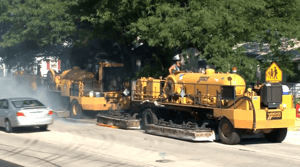.png?width=663&name=Reducing%20Driver%20Delays%20Header%20(1).png)
The average driver "from an urban center" spends 42 hours per year sitting in traffic*. That's an entire extra work week. We all know that time increases due to road maintenance and construction. Some of the negative impacts that can result from construction are:
- Long delays
- Road rage
- Accidents
- Blocked emergency vehicle access
- Increased fuel emissions
- Noise
- Reduced air quality
- Negative impact on local businesses
Nobody wants to see these issues arise as a result of improving the community. Some delays are inevitable, but as the great inventor Charles Kettering says,
"Problems are the price of progress..."
THE CURE CAN'T BE WORSE THAN THE DISEASE
The goal with any road asphalt resurfacing project is to repair issues in the road like potholes, reflective cracks and ruts. Resurfacing projects are necessary every 12-20 years. The challenge for public agencies is to minimize the negative aspects of the resurfacing process while getting all of the benefits of a new asphalt surface. There is a better option. Let’s compare Hot In-Place Recycling to a traditional mill and fill to see how Hot In-Place Recycling compares in terms of user delays.
COMPLICATED LANE CLOSURES
MILL AND FILL
|
HOT IN-PLACE RECYCLING
|
|
The truck + the milling machine requires a multi-lane closure
to make room for trucks and equipment. These long-term
closures are frustrating and dangerous for drivers.
|
The equipment for HIR equal 120 feet total and only uses one lane.
This means temporary lane restrictions that are lifted throughout each work day for less delay.
|
TOTAL STEPS REQUIRED
MILL AND FILL
|
|
HOT IN-PLACE RECYCLING
|
|
The traditional mill and fill requires a separate process for asphalt removal, placement of a tack layer, and then replacement of the
asphalt. Extra steps and pauses in between steps ultimately mean
extra time for delays and more frustrations.
|
|
Hot In-Place Recycling is completed in a single pass from start to finish. All that is then required is the final hotmix overlay or surface treatment; typically within the same week. Reduced pauses between steps means much less overall disruption and restrictions.
|
TRUCK TRAFFIC
MILL AND FILL HOT IN-PLACE RECYCLING
|
The “normal” 2.25" asphalt resurfacing takes requires 215 truck trips per mile. That's a lot of trucks for normal traffic to have to drive around.
|
HIR means no trucking required if no new structure overlay is added. The necessary pavement preservation treatments can be done without trucking depending on the method.
|
HOT IN-PLACE RECYCLING FOR THE WIN

In every category, Hot In-Place Recycling helps you take a detour around many common causes of driver delay during road resurfacing. This means:
- Quicker completion of projects (we’ve heard up to 20%)
- Fewer phone calls from irate drivers
- The opportunity to fix more roads in the same amount of time
THE BENEFITS DON’T STOP AT DRIVER DELAYS
In addition to the benefits for drivers, Hot In-Place Recycling also means:
- Costs reduced by up to 34%
- Reduced carbon footprint by up to 28%
- 100% recycled asphalt of existing pavement replacement
CAN HOT IN-PLACE RECYCLING
REDUCE YOUR DRIVER DELAYS?

*Source: https://bestlifeonline.com/traffic-commute-times/#:~:text=According%20to%20the%20Texas%20A%26M,sitting%20in%20traffic%20every%20year